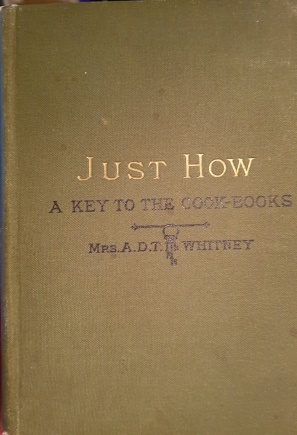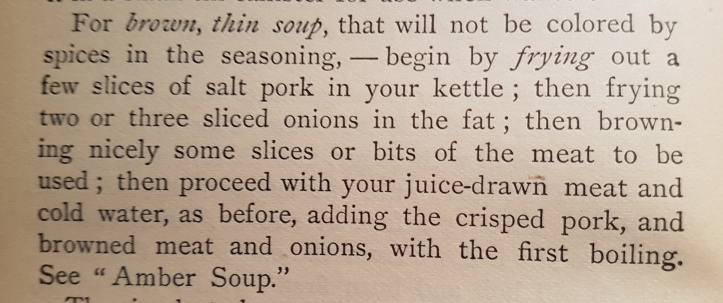 “Cut the meat small, and chop the bones in pieces.”
“Cut the meat small, and chop the bones in pieces.”
So begins the chapter on soups in Just How, A Key to the Cook-Books by Mrs. A. D. T. Whitney, originally published in 1878. Though the book is small, the author attempts to fully explain the steps required in the basic categories of cooking, and just how to cook different things, and why that way works.
“I do not wish, or expect, to replace or render useless the fine compendiums of housewifery like Marion Harland’s, Mrs. Cornelius’s, Mrs. Putnam’s, and others. I only put in your hands a little primer, which you can learn first and turn back to when you want any rule to help you through with a difficult construction in an advanced and general work.”
Today, I’m only going to look at the soup chapter. The beginning is full of choice pieces of advice, like to always start with cold water, and to make the broth for soup the day before it is required, so it can be cooled and the fat can be removed before the second boiling. And always, always, set the soup kettle at the back of the range or stove where it will warm very gradually.
Then Mrs. Whitney goes on to discuss seasonings and other flavourings, thickening, and instructions for browning flour, which can be made in advance in bigger quantities and stored in a small tin canister for use when wanted. But the author also warns us that browned flour doesn’t thicken soups as well as unscorched flour, and that she finds it better to use plain flour, and colour the soup, if necessary, with carefully burned sugar.
For spicing, she doesn’t give any specific quantities, but cautions the cook to add pinches or even half pinches and then taste. Salt should be added until the soup is “bright-tasting,” and pepper, until the soup is “just on the brink of pungency, but never over.” She suggests a fairly wide range of spices, herbs and seeds, and advises that each flavouring should hide itself and help all the rest. No one seasoning should stand out.

She addresses the usual soup additives: soak barley overnight, and cook separately from the soup in as little water as possible, then add to the soup, with its cooking water, at the end. Rice, sago, hominy, farina, vermicelli and macaroni are also recommended.
These soup-making guidelines were probably fairly commonly known only a few generations ago. Now that soup comes from a tin, and bone broth is considered a new food, I’m guessing that the finer points of soup making are becoming unfamiliar to many. I’ll end this post with a few recipes from Mrs. Whitney to get you started.
Beef Soup
Prepare your stock the day before, according to general directions. When the meat has been gently boiling two hours, add to it – for, say a two-gallon kettle originally nearly full of meat and liquor* – one large or two small carrots, cut in slices. – One turnip, cut small. – One coffee-cup full of chopped white cabbage. – Six fresh tomatoes, sliced, or a small can of sealed ones. – Three common sized onions, sliced.
Cover tight and boil, always gently, as slowly as possible without stopping, two hours or more, or until the meat is juiceless, and the vegetables well boiled up. Then strain and set away.
The next day, skim the fat off, pour the soup through a fine strainer into the kettle an hour before dinner. Cover it close, and let it come to a boil. Season with salt, unless ham or other salt meat has been used in the first boiling, so as to render it unnecessary; pepper, mace, clove, added cautiously; a pinch of curry; a teaspoonful of celery salt, at the very last a lemon sliced thin, and put in in time for only one boil-up. Have three or four eggs boiled hard, cut in bits in the tureen into which you pour the soup for the table. Stir, and serve.
* By liquor, she means the water the meat was cooked in, not booze!
I have the 14th impression, published in 1900. My copy was originally purchased from W.B. Clarke Co. in Boston.
You actually make it appear really easy together with your presentation however I to find this matter to be actually something which I think I’d by no means understand. It sort of feels too complex and very vast for me. I’m looking forward on your next post, I’ll attempt to get the dangle of it!
LikeLike
I’m not sure if it’s really as easy as she makes it sound, but it’s not too hard!
LikeLike